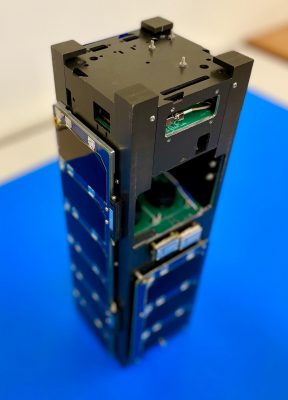Dr. Ed Cloutis and his team of researchers at the Centre for Terrestrial and Planetary Exploration (C-TAPE) are contributing their expertise to the UM CubeSat project – a new satellite that will be deployed from the International Space Station.
The project is led by University of Manitoba engineering students within the Space Technology and Advanced Research Laboratory (STARLab). As well as the UWinnipeg team, it also includes collaborators from York University, Interlake School Division, and Magellan Aerospace.
The compact satellite, which is about the size of a milk carton, was chosen by the Canadian Space Agency as part of the CubeSat project, an initiative created to provide professors in post-secondary institutions an opportunity to engage students in a real space mission. Selected teams build their own miniature satellite called a CubeSat.
Dr. Cloutis’ team helped design and build the payload for the project.
“Cross-collaboration is essential. Each of our institutions and students bring complementary experience into the project,” said Dr. Cloutis. “This mission is very much a marriage between geology and engineering. It’s been a real pleasure and privilege to work with the team at U of M to turn this vision into a reality.”
The satellite will collect information on how space conditions affect the appearance of the surfaces of asteroids and the Moon. Data from the satellite will be sent back to Earth for study – and will help researchers understand how the appearance of the surfaces of asteroids and the Moon can change over time. This will, in turn, improve the ability to map their geology and understand their origin and evolution.
The satellite will be integrated with the NanoRacks deployment system at the Canadian Space Agency in St. Hubert, Quebec during the week of March 27, and then shipped to Cape Canaveral, Florida for launch in early June. It will take a couple of days to reach the space station. Astronauts will eventually mount the deployment mechanism on a robotic arm in one of the airlocks of the space station.
The team expects the “first contact” to happen sometime in July or August. After that, the satellite will operate for approximately one to three years until its orbit eventually decays and it burns up in the Earth’s atmosphere.
About Dr. Ed Cloutis
Dr. Ed Cloutis has more than 25 years of expertise in earth and planetary remote sensing. His research focuses on developing new applications of remote sensing to explore the surface of the Earth and planets in the solar system, both for geology and the search for extraterrestrial life.
He’s the Founder and Director of C-TAPE, a state-of-the-art lab dedicated to advancing planetary exploration, and a member of science teams associated with a number of planetary exploration missions, including the NASA-led Dawn asteroid rendezvous mission, NASA’s Mars Perseverance rover, the NASA Mars Science Laboratory (Curiosity) rover, the NASA-CSA OSIRIS-REx asteroid sample return mission, and the European Space Agency’s ExoMars Trace Gas Orbiter and ExoMars rover.






